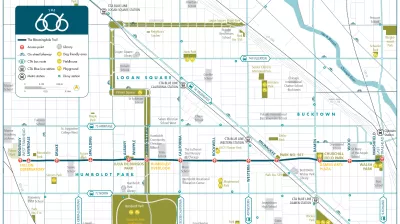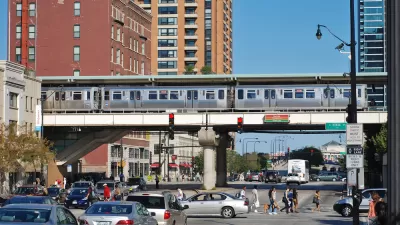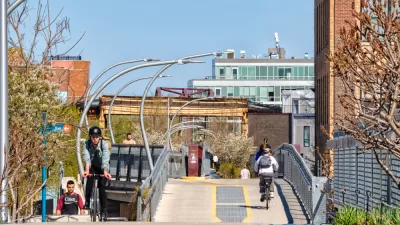Following in the footsteps of the High Line in New York City, Chicago opened a 2.7-mile elevated park, which has already been extremely popular in its first week. Here we round up the initial reactions to The 606, as the new park is called.

"Chicago’s long-awaited bikeway and elevated park, The 606, opened last weekend (on 6/6, no less) to a rush of pedestrians and cyclists who were eager to test out the new 2.7-mile trail after years of planning, design and construction," according to Chris Bentley.
The 606, formerly called the Bloomingdale Trail, "is as much a highway for bikes as anything else, due in part to its having been largely funded through the U.S. Department of Transportation’s Congestion Mitigation and Air Quality (CMAQ) improvement program."
Steven Vance created a time-lapse video of the entire length of The 606, which you can watch here. Vance also wrote for Streetsblog Chicago to explain how he made the video.
Bicycling west to east on the Bloomingdale Trail from Steven Vance on Vimeo.
Writing for Landscape Architecture Magazine, Zach Mortice offers more details about the funding and political support necessary for the park as well as more details about the design of the route.
FULL STORY: RIDE CHICAGO’S NEW ELEVATED PARK AND BIKE PATH, THE 606, WITH THIS TIME-LAPSE VIDEO

Manufactured Crisis: Losing the Nation’s Largest Source of Unsubsidized Affordable Housing
Manufactured housing communities have long been an affordable housing option for millions of people living in the U.S., but that affordability is disappearing rapidly. How did we get here?

Americans May Be Stuck — But Why?
Americans are moving a lot less than they once did, and that is a problem. While Yoni Applebaum, in his highly-publicized article Stuck, gets the reasons badly wrong, it's still important to ask: why are we moving so much less than before?

Using Old Oil and Gas Wells for Green Energy Storage
Penn State researchers have found that repurposing abandoned oil and gas wells for geothermal-assisted compressed-air energy storage can boost efficiency, reduce environmental risks, and support clean energy and job transitions.

Updating LA’s Tree Rules Could Bring More Shade to Underserved Neighborhoods
A new USC study finds that relaxing Los Angeles’ outdated tree planting guidelines could significantly expand urban tree canopy and reduce shade disparities in lower-income neighborhoods, though infrastructure investments are also needed.

California's Canal Solar Projects Aim to Conserve Resources and Expand Clean Energy
California’s Project Nexus has begun generating electricity from solar panels installed over irrigation canals, with researchers and state agencies exploring statewide expansion to conserve water and boost clean energy production.

HHS Staff Cuts Gut Energy Assistance Program
The full staff of a federal program that distributes heating and cooling assistance for low-income families was laid off, jeopardizing the program’s operations.
Urban Design for Planners 1: Software Tools
This six-course series explores essential urban design concepts using open source software and equips planners with the tools they need to participate fully in the urban design process.
Planning for Universal Design
Learn the tools for implementing Universal Design in planning regulations.
Heyer Gruel & Associates PA
City of Moreno Valley
Institute for Housing and Urban Development Studies (IHS)
City of Grandview
Harvard GSD Executive Education
Salt Lake City
NYU Wagner Graduate School of Public Service
City of Cambridge, Maryland




























